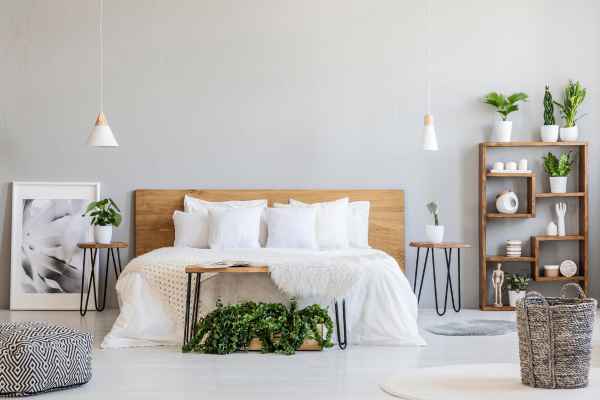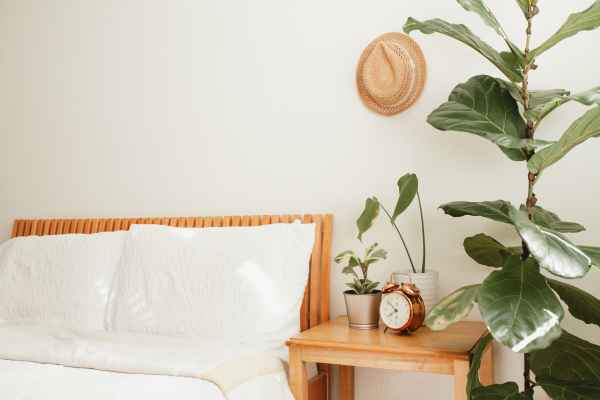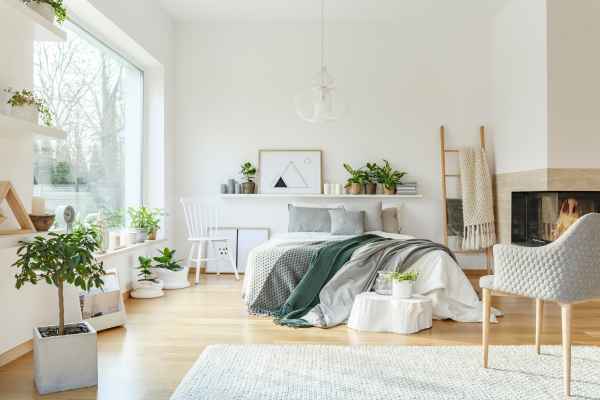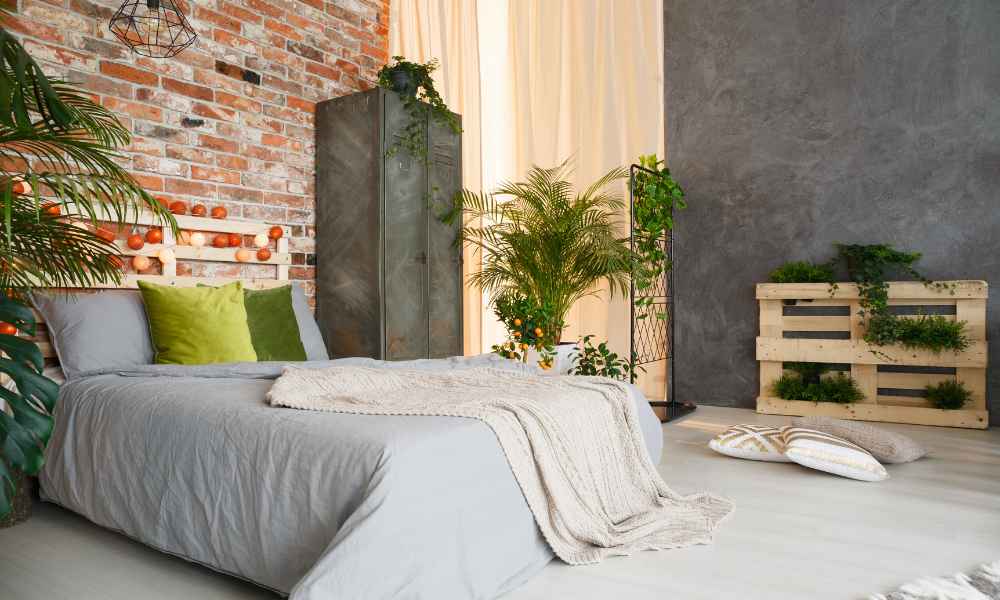In today’s world, where living spaces are often compact, the art of maximizing space in small bedrooms is crucial. It’s not just about creating an illusion of more space, but also about enhancing functionality and comfort. Meanwhile, incorporating plants into bedroom decor isn’t just a trend; it’s a health-boosting, mood-enhancing strategy. Plants add a breath of fresh air, literally and figuratively, transforming a simple bedroom into a serene sanctuary. Together, these approaches can revolutionize the way we perceive and enjoy our personal spaces.
Understanding Space Dynamics

Understanding space dynamics in a small bedroom begins with a careful assessment of the layout, identifying how best to utilize each inch. It’s about recognizing the key areas where plants can be integrated, not just for aesthetics but also for their calming effect. Crucial to this process is the understanding of scale and proportion. Furniture and decor must harmonize with the room’s dimensions, ensuring neither overcrowding nor underutilization. This balance creates a space that feels both spacious and comfortably furnished, blending functionality with a touch of nature.
Selecting Suitable Plants for Small Bedrooms

Choosing plants for small bedrooms, it’s essential to consider varieties that thrive in low-light conditions, as these spaces often lack ample natural light. Opt for small and compact plants that complement rather than overwhelm the limited space. Equally important is selecting air-purifying plants, which not only enhance the room’s aesthetics but also contribute to a healthier living environment. These plants can improve air quality, reduce stress, and promote restful sleep, making them ideal for compact bedroom spaces.
Efficient Use of Vertical Space

Efficient use of vertical space is key in compact areas, and this approach can be creatively applied in small bedrooms through the incorporation of plants. Hanging plants offer a way to bring greenery into the room without occupying floor space, creating a refreshing overhead canopy. Wall-mounted planters serve as both decorative elements and space savers, adding a touch of nature at eye level. Utilizing shelves for small potted plants transforms bare walls into vibrant displays, effectively turning an unused vertical expanse into a living, breathing part of the room’s decor.
Making Use of Horizontal Surfaces

Making the most of horizontal surfaces in small bedrooms for plant decoration can significantly enhance the room’s ambiance. Placing plants on window sills not only utilizes this often-overlooked space but also allows plants to benefit from natural light. Small plants on bedside tables or dressers can add a touch of tranquility without cluttering these essential surfaces. Additionally, incorporating terrariums as decorative elements offers a unique and low-maintenance way to bring miniature landscapes indoors, creating focal points that captivate and soothe. These strategies collectively contribute to a harmonious and nature-infused bedroom environment.
Creative Plant Display Ideas

Embracing creativity in plant display can transform a small bedroom into a vibrant, green haven. DIY plant stands are a fantastic way to add a personal touch, allowing for custom designs that fit specific spaces and styles. Multi-tiered plant holders are another ingenious solution, offering vertical layers for showcasing a variety of plants without taking up much floor space. Floating shelves for plants are a sleek, modern option, creating an airy feel while displaying greenery at different levels. These creative ideas not only maximize space but also add a dynamic and inviting element to bedroom decor.
Combining Plants with Other Decorative Elements

Integrating plants with other decorative elements in a bedroom can create a cohesive and inviting space. Coordinating plant colors and textures with the bedroom’s color scheme enhances the overall aesthetic appeal. For those with themed decor, such as a minimalist or bohemian style, incorporating plants can add depth and complement the theme. Plants can be strategically placed to draw attention to specific areas or to balance out the room’s aesthetics, serving as natural, vibrant accents. This thoughtful combination of plants and decor elements leads to a harmonious and personalized bedroom environment.
Functional Considerations in Plant Decor

Incorporating plants into small bedroom decor requires mindful consideration of functionality. It’s important to avoid overcrowding the space with too many plant, which can create a cluttered feel and impede movement. Instead, select a few key areas for plant decoration to maintain accessibility and ensure the room remains open and inviting. Additionally, plant care and maintenance should be practical in a small space. Choose plants that require minimal care and consider their placement for ease of watering and sunlight access. This balance ensures the plant decor enhances the bedroom’s functionality and aesthetic, rather than hindering it.
Innovative Container and Planter Ideas

Innovative container and planter ideas can add a unique touch to small bedroom spaces. Repurposing items like vintage cans, teacups, or colorful bottles as plant containers infuse personality and reduce waste. Space-saving planter designs, such as vertical planters or hanging pots, are essential for compact areas, allowing for a greener environment without sacrificing floor space. When choosing planters, considering their color and texture is crucial, as these elements should complement the room’s decor and create a cohesive look. These creative solutions not only cater to practicality but also bring an artistic and personalized flair to plant decoration.
Lighting and Plants in Small Bedrooms

In small bedrooms, the interplay between lighting and plants is crucial for creating a comfortable and lively space. Ensuring adequate natural light for plant health is paramount, as it influences their growth and vibrancy. In rooms with limited sunlight, using artificial lights specifically designed for plant growth can be a practical solution, helping plants thrive while maintaining their decorative appeal. Additionally, creatively positioning plant can enhance the effect of mood lighting, with foliage casting soothing shadows or being backlit for dramatic effect. This thoughtful integration of lighting and plants not only supports plant health but also contributes to the overall ambiance of the room.
Seasonal Adjustments and Rotations
Seasonal adjustments and rotations in plant decor can rejuvenate and refresh the ambiance of space throughout the year. Changing plants according to the season not only aligns the indoor environment with the natural world outside but also ensures that the plant are suitable for the varying light and temperature conditions. For instance, spring might welcome bright, flowering plants, while autumn calls for more resilient, foliage-based varieties. Additionally, incorporating temporary decorative plant arrangements for special occasions or to mark the changing seasons adds a dynamic and festive element to the decor. This approach keeps the space feeling alive and connected to the rhythm of nature.
Addressing Common Concerns
Addressing common concerns in maintaining indoor plants, especially in small spaces, is essential for a thriving green environment. Managing soil and water balance is crucial; overwatering can lead to root rot, while under-watering stunts growth. This requires selecting the right soil type and establishing a consistent watering routine. Dealing with limited natural light can be challenging, but choosing low-light-tolerant plant or using artificial plant lights can mitigate this issue. Additionally, keeping plants healthy in small spaces involves regular pruning, ensuring adequate air circulation, and monitoring for pests. These practices ensure that indoor plant not only survive but thrive, enhancing the beauty and ambiance of the space.
Inspirational Examples and Case Studies
Inspirational examples and case studies of plant decor in small bedrooms showcase the transformative power of greenery in interior design. Real-life examples often feature ingenious ways homeowners have integrated plant into limited spaces, creating serene and lively environments. These cases highlight how even the smallest bedrooms can be revitalized with strategic plant placement. Additionally, creative solutions from interior designers provide a wealth of inspiration. They demonstrate how various plant types, container styles, and placement techniques can be harmoniously combined to enhance both aesthetics and functionality. These examples not only inspire but also offer practical ideas for those looking to rejuvenate their own spaces with plants.
What types of plants are best for a small bedroom?
- Opt for plants that are well-suited to indoor environments and don’t require a lot of space to thrive. Some excellent options include:
- Succulents: These small, low-maintenance plants come in various shapes and colors and are perfect for adding a touch of greenery to tight spaces.
- Air Plants: These unique plants don’t require soil and can be displayed in creative ways, such as hanging or mounted on walls.
- Spider Plants: Known for their air-purifying properties and ability to thrive in low light conditions, making them ideal for bedrooms.
- Pothos: A versatile and easy-to-care-for plant that can be displayed in hanging baskets or placed on shelves to add vertical interest.
Conclusion
The key strategies for incorporating plants in small bedrooms involve thoughtful selection of plant types, efficient use of space, and creative container choices. Balancing functionality with aesthetic appeal, these strategies emphasize the importance of light management, seasonal adjustments, and regular maintenance to ensure plant health. Encouraging personalization and experimentation, these approaches invite individuals to explore and express their unique style, creating a living space that is not only visually appealing but also a true reflection of their personality. The journey of decorating with plant in small spaces is as rewarding as it is enriching, fostering a deeper connection with nature.
